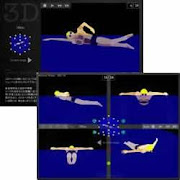 We came across the following from inventors Jacques Chauvet and David Conroy who submitted a shark deterrent device patent application to the US Patent and Trademark Office:
We came across the following from inventors Jacques Chauvet and David Conroy who submitted a shark deterrent device patent application to the US Patent and Trademark Office:A shark deterrent device comprises at least two hollow cylindrical shafts, a tip, a twist-release mechanism, and at least one self-lock mechanism. The tip may be replaceable. The shark deterrent device is a retractable unit that is easy for a diver to carry and stow, and yet can be extended in order to deter a shark. The device is unlocked from its retracted position by twisting a collar, thereby unlocking the concentric shafts and allowing the unit to be fully extendable by hand. Once the unit is fully extended, a self-lock mechanism lock the unit to prevent it from retracting during use. The unit has a handle formed at one end of the outermost cylindrical shaft and a tip at the opposing end of the innermost cylindrical shaft. The tip may be replaceable and removed, and other useful tips may be attached.
[Field of Invention] The present invention relates to a device for deterring shark attacks. In particular, the device provides the user with a telescopic blunt object with which to prevent a shark from coming too close, while reducing the potential for injury to the shark.
[Background] Shark attacks are a common fear of scuba divers. In order to prevent these attacks, divers often carry with them various shark deterrents, such as chemical repellents or spear guns. Chemical repellents are often not allowed in ecological fragile areas, and are often of only limited effectiveness.
Sharks rarely attack in a straightforward manner. The most common method of shark attack is known as a "circling attack." A circling attack is when a shark starts to circle its prey widely, and gradually reduces the diameter of the circle until the shark is close enough to "bump" its snout into the prey. This "bump" allows the shark to use its electroreceptors to identify its prey before the "test bite." Since sharks are known to be scavengers they often are attracted to an easy prey. When sharks encounter prey that fights back, they have been known to retreat.
Thus, there is a need in the industry for a non-chemical, non-wounding device that will deter sharks and yet is easy for a diver to carry and open. This device may be used when a shark attempts to approach or "bump" a diver, acting as a deterrent and causing the shark to retreat and leave the diver in search of easier prey.
[Summary] Responsive to the foregoing challenges, Applicant has developed an innovative device for deterring sharks. The device is comprised of at least two, and in one embodiment three hollow shafts that may be cylindrical, a replaceable and/or interchangeable tip, a spring disposed in at least one hollow shaft to partially extend or open the device; a twist-release, or similar release, mechanism, and at least one, and in one embodiment, two self-lock mechanisms. The shark deterrent is a retractable unit that is easy for a diver to carry and stow, and yet can be easily extended in order to deter a shark. The device is unlocked from its retracted position by twisting a collar or using a similar release mechanism, thereby unlocking the concentric shafts and allowing the spring to partially or fully extend the device, and if necessary the device may then be fully extended by hand. Once the unit is fully extended, self-lock mechanisms lock the unit to prevent it from retracting during use. The unit has a handle formed at one end of the outermost shaft and a replaceable and/or interchangeable tip at the opposing end of the innermost shaft. The replaceable tip may be removed, and other useful tips may be attached. In various embodiments, the interchangeable tips may include, but are not limited to, a hook, a spear, a net, a flashlight, a Light Emitting Diode (LED), or a shovel. In some embodiments the apparatus may include a spring or other similar mechanism to partially or fully extend at least one of the concentric shafts upon release from the retracted position.




















No comments:
Post a Comment